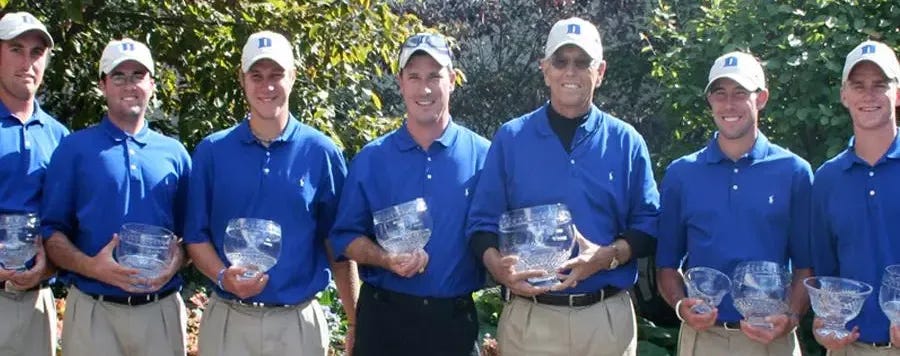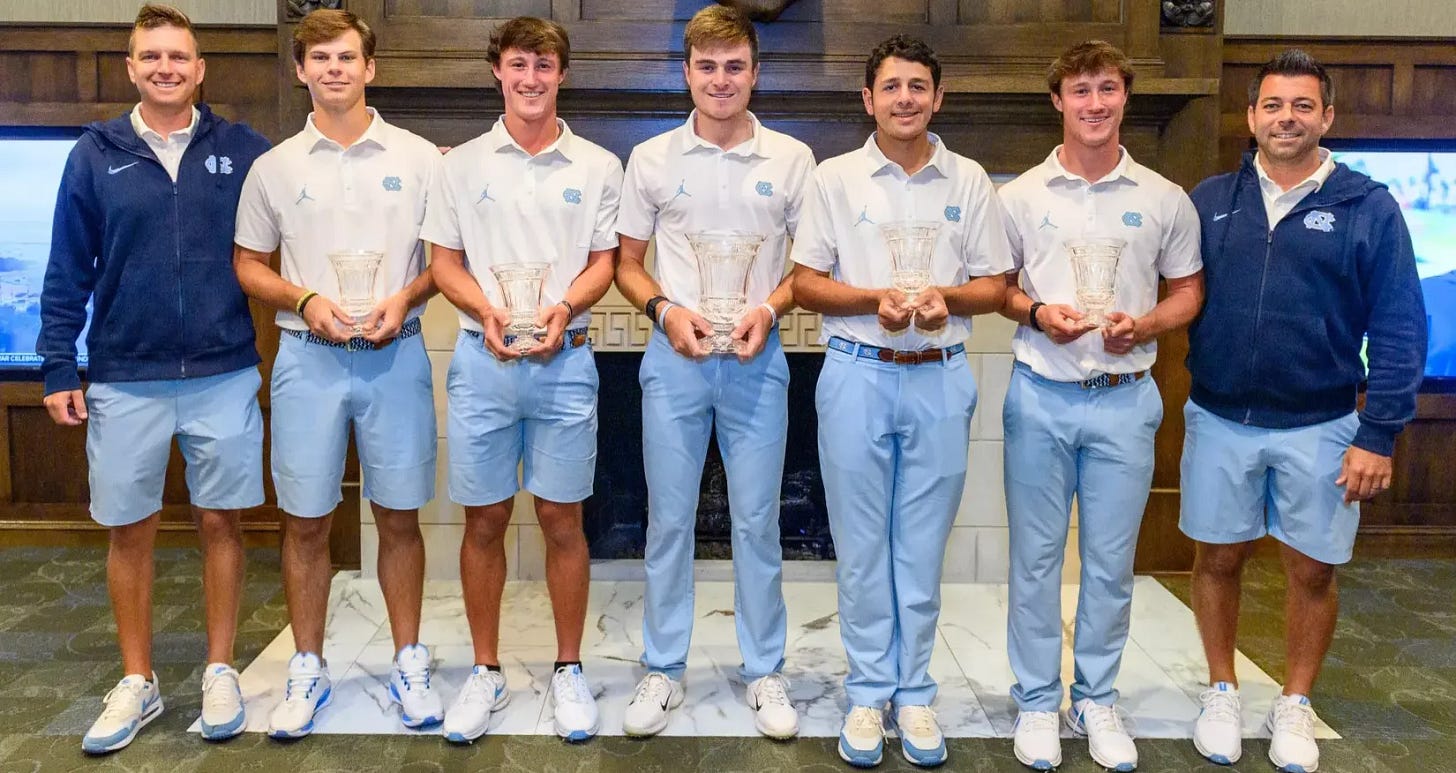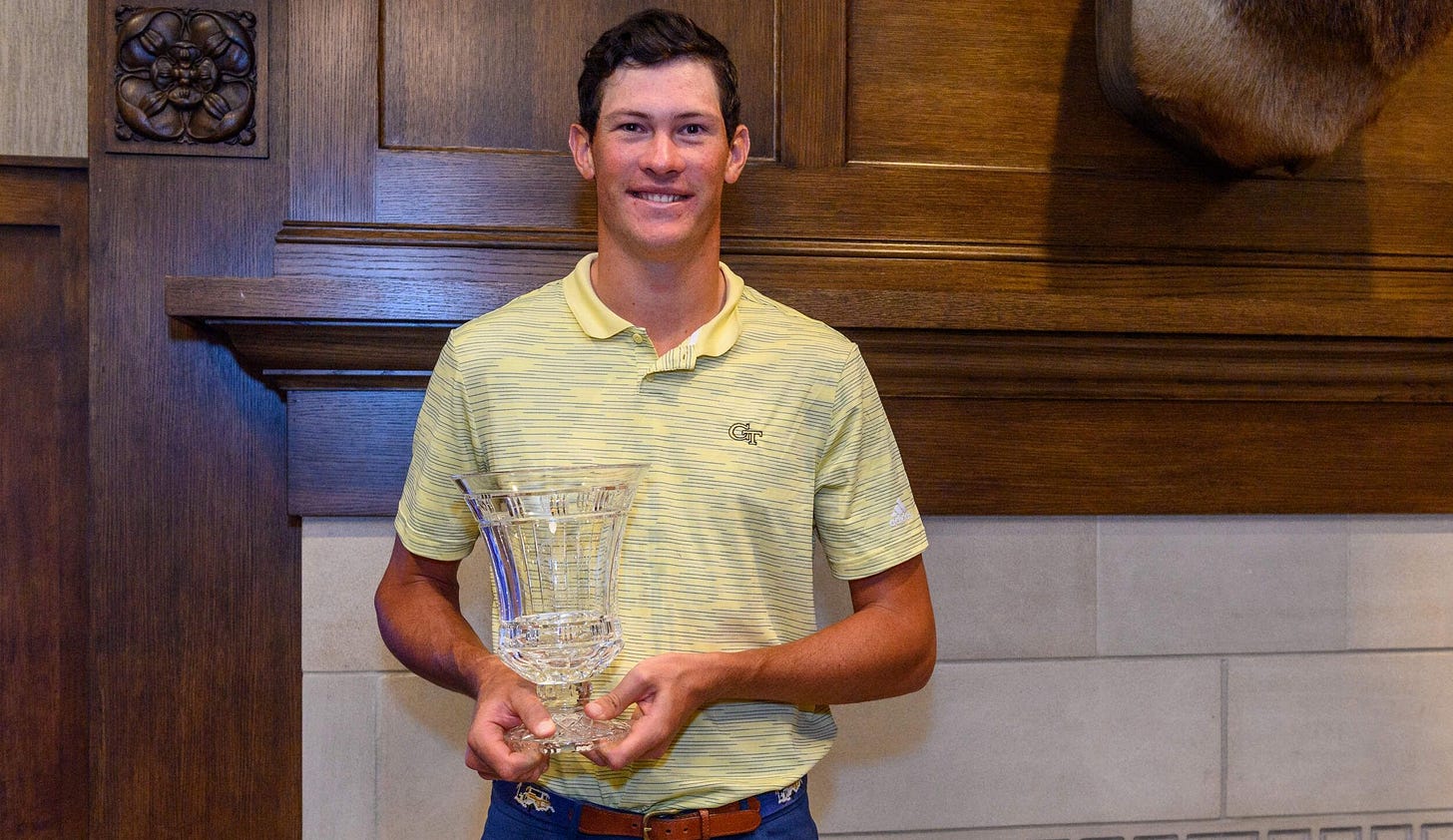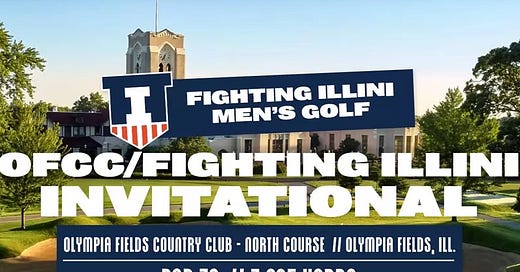Historic Tournaments: OFCC-Fighting Illini
Thousands of different tournaments have been played throughout college golf’s long history. Given the challenges of money, time, weather, and course availability, any tournament that runs more than a handful of times would be considered a huge success by any measure. The ones that have lasted across decades are labeled as historic and usually come with their own unique flair steeped in tradition. One such tournament is hosted by Illinois at famed Olympia Fields Country Club, known as the OFCC-Fighting Illini.
History
Five years passed between the Illinois men’s golf team hosting the 2000-01 Big Ten championship at Stone Creek GC and getting to host another home tournament. Head Coach Mike Small was excited to initiate what he hoped would be an annual tournament, telling the school news staff:
"We're excited that this event is finally here. This is a great opportunity to showcase Olympia Fields to some of the nation's top teams. It is also great exposure for our program to have our players competing on an excellent course against top-level competition."
Indeed, the inaugural OFCC-Fighting Illini Invitational was a great kickoff to the 2006-07 season, even though the home team didn’t come out with the victory. Oklahoma State, the defending NCAA champs and preseason #1 team, was the headliner in a loaded field, however it was Duke - who had finished 13th in their season opening tournament - that rallied in the final round to take a commanding 6-shot victory, finishing +24/864 (par 70). Arizona State All-American senior Niklas Lemke picked a great time to earn his first collegiate medalist honors with a final round -4/66 to beat out a pair of Duke teammates and the preseason #1 player, Pablo Martin [Oklahoma St].

That first tournament in 2006 set the tone for a tough but incredible event, and since then the OFCC-Fighting Illini has continued to be one of the best regular season events each year for the last 18 seasons (with the exception of the 2020-21 season when the Big Ten did not play a Fall season). Played in mid-September at that balancing point between summer and fall, it’s the perfect way to start the first half of the college golf season, and provides an early litmus test for teams expecting to make a run at the NCAA championship the following May. In fact, teams that have won the OFCC-Fighting Illini have always gone on to make the NCAA championship field. The 2013-14 Alabama team that repeated as national champions started out their season with a victory at Olympia Fields. In total, seven OFCC-Fighting Illini team winners have gone on to make NCAA match play (two additional lost playoffs after finishing T8), three of which (co-)medaled in the stroke play portion.
Earning medalist honors at any tournament is a big deal, but perhaps even more so for an event of this caliber. Despite being an early season tournament, the vast majority of OFCC-Fighting Illini medalists went on to be named to one of the All American Teams and are recognizable names to even casual fans. For several players, this tournament was the beginning of a special season and a strong point on the resume for national award consideration. After winning the 2007 edition, Oklahoma State freshman Rickie Fowler went on to also win the Big12 championship and become the first freshman to win the Ben Hogan Award along with the Phil Mickelson Freshman Award. Alabama freshman Robbie Shelton also went on to win the Mickelson Award after earning co-medalist honors in his first ever collegiate tournament which happened to be at this event in 2013. In total, OFCC-Fighting Illini medalists have earned several national awards including: two Haskins Awards (McNealy and Wolff), two Nicklaus Awards (McNealy and Wolff), two Mickelson Awards (Fowler and Wolff), the Hogan Award (Fowler), the Byron Nelson Award (Lamprecht), and two Arnold Palmer Awards given to the NCAA individual champion (Wilson and Wolff). This doesn’t even begin to cover the multitude of conference awards and recognitions that proudly adorn the practice facility walls of the medalists’ respective teams.

The most recent edition of the OFCC-Fighting Illini was the first to be so effected by weather that it was forced to be cancelled after 36 holes. The 2023-24 North Carolina Tar Heels blitzed the course, setting several scoring records and likely would have broken a few more had they been able to play the final round. Likewise, UNC’s Maxwell Ford was perhaps on his way to breaking the individual scoring record, but ultimately was one stroke shy of Georgia Tech’s Christo Lamprecht for medalist honors. Both UNC and Georgia Tech were heavily in the mix at the 2024 NCAA championship, making match play but losing in turn to eventual runner-up Florida State.


VENUE

A three minute drive northbound from the Walmart on Western Avenue in the small town of Olympia Fields, IL, will bring you to a rather unassuming t-intersection intersection. As you idle in the left lane waiting for traffic to clear to make your left-hand turn, you take note of the brick Methodist Church on your right as well as the nice but modest homes lining the street on your left. If it wasn’t for a relatively small beige sign sporting the club logo and an arrow pointing westward down Country Club Drive, you might question whether you’re going the right way. That feeling persists for another minute as you reach the four-way stop at Oakwood Drive, but a couple more seconds down the road and you find yourself driving past some larger homes on the right and nice metal fence lining the golf course on the left. Your pulse quickens as you steal glances away from the road, trying to make out the course between the trees. A quick stop at the guard post and suddenly you’re on property, approaching one of the most stunning clubhouses you’ve ever seen.
Undoubtedly one of the biggest reasons this event is so special is because of the elite venue, Olympia Fields Country Club. The North Course in particular is often ranked comfortably inside the top 100 courses in the United States if not the world. Andy Johnson of the Fried Egg wrote a fantastic profile on the course in 2016 in which he described the Willie Park Jr designed course as “Pure Championship Golf.” It’s steeped in history, having hosted the US Amateur, US Opens, US Senior Opens, PGA Championships, Western Opens, and BMW Championships. When players arrive for their practice rounds they inevitably want to relive some of the most memorable shots from the past few decades including Tiger Woods’ famous shot in the 2003 US Open or the dual putts from Jon Rahm and Dustin Johnson from the back of #18 green in the 2020 BMW Championship.
OFCC is truly an incredible place to spend any day, and it’s no wonder the OFCC-Fighting Illini tournament annually draws one of the most elite fields in college golf regular season play. Some teams are even fortunate enough to stay in the small hotel on property, making for a unique and unforgettable experience.
SCORING RECORDS

The famed Olympia Fields CC North Course plays much tougher than the par 70 scorecard might suggest. Even still, elite collegiate players have have managed to put together an impressive array of scoring records.
Stanford’s 2022-23 team came out hot to begin the 2022 event, setting the first round record with a -10/270 and eventually winning the tournament at -9/831. The overall lowest single-round score belongs to last year’s UNC team which blistered the course with counting scores of 65-67-68-69=269/-11 in the second (and final) round. Paired with their first round score of 281/+1, UNC now also holds the 36-hole record.
The closing round of any tournament can be never-wracking, making Texas A&M’s 2017 final round score of -9/271 (at that time the single-round record) very impressive; even more so considering the next closest score that day was +3/283! The 54-hole team record belongs to the 2018-19 Oklahoma State team that ran away from the field, posting a 829/-11 score that was 18 strokes better than their nearest competitor.
The lowest individual round scoring record of 63/-7 was achieved in the second iteration of the event when Oklahoma State’s star freshman Rickie Fowler shot one of only four rounds under par in the 2nd round of the 2007 tournament. That score has since only been matched once, in 2015 when Illinois’s own Thomas Detry was one of only five scores under par to open that tournament. In 2022, Florida State’s Cole Anderson came close when he set a new low round 3 scoring record with his 64/-6 which boosted him to a T6 finish.
Only 31 of the 1272 players (~2.4%) in this event’s history have managed to shoot in the 60s in both the first and second rounds of their tournament. The lowest scoring of these was Christo Lamprecht’s 2023 65-66=131/-9, which is the current 36-hole individual scoring record. Only 5 players have shot in the 60s all three rounds, including Alabama’s Davis Riley who won the 2017 edition with rounds of 66-67-67=200/-10. The next closest was Illinois’s own Nick Hardy who finished runner-up that same year after rounds of 66-68-69=203/-7.
DATA DIVE
One of the nice things about having a long-running tournament played at the same course is the ability to compile and analyze records across multiple decades of players. We can see from the chart above how the final score (relative to par) for the winning team has fluctuated over the years, with the highest coming in 2009 (Arizona State +30) and the lowest in 2018 (Oklahoma State -11).
Digging deeper into the stats, we can see that Oklahoma State’s 2018 finish was impressive not only from their raw score but also their Strokes Gained Total (SGT)1 value which put them at +39.7 strokes better than the field average. This was undoubtedly helped by the last place team finishing a record -53.3 strokes below the field average, but Oklahoma State also was an incredible 27 strokes better than 3rd place and 31 strokes better than 5th place. Using this SGT data, we can see that perhaps one of the more impressive wins was Arkansas’s 2012 victory which wouldn’t stand out from a raw score perspective (+14), however they were +34.5 strokes better than the field average and the last place team had a relatively-low -24.5 SGT.
Despite the low scoring in the 2023 edition, there was only a 36 stroke differential between the winning UNC team (+17.4) and the last place finishing team (-18.6). It’s a safe assumption, though, that this likely would have increased had they played the final round. Only one other tournament had that close of a differential between first and last after 54 holes: the 2007 event where Oklahoma State shot +17 and had an SGT of +21.5, while the last place team shot +53 for an SGT of only -14.5.
As you might imagine, the (co-) medalist scores over the years have fluctuated to generally match the pattern of the winning team score. Oklahoma State’s Rickie Fowler set the initial low scoring record in 2007 with a blistering 203/-7. It was matched only one other time (2015 by Stanford’s Maverick McNealy) before being broken by the current record holder, Alabama’s Davis Riley, in 2017 with his incredible 200/-10 performance. Last year’s winner, Christo Lamprecht of Georgia Tech, was in prime position to beat that record had the weather cooperated enough to play the final round.
Once again we can use the SGT data to identify some trends and outliers. Instead of looking at the last place finisher, we chose to look at the top 20 scoring to find interesting differentials. The obvious standout is Rickie Fowler’s 2007 victory which not only established the raw scoring record for a long time, but also illustrates the dominance of that performance with a record +19.5 SGT and a differential with the top 20 finisher(s) of 17 strokes! Davis Riley’s 2017 performance, which broke Rickie’s record, had the next highest differential (19.1 to 5.1 = 14 strokes). The closest bunching came in 2008 when Illinois’s Zach Barlow and Indiana’s Alex Martin co-medaled at -1/209 and had a relatively low +13.2 SGT which was only 7 strokes better than 20th place.
Another strong performance that might otherwise go underappreciated was Patrick Rodgers’s [Stanford] victory in 2011 where his 206/-4 finish didn’t set records, but there was an 8 stroke differential between him and 5th place and only a 3 stroke differential between 5th and 20th places.
2024 PREVIEW [Sep 20-22, 2024]
The 18th playing of this tournament looks to be as competitive as ever. Three of the top 5 and six of the top 10 teams in the preseason coaches poll are in the field. In fact, nearly the entire field received votes to be in the top 25. We expect whoever comes out on top of this incredibly strong event to be in the mix at the end of the season.
Preseason Bushnell/Golfweek D1 Coaches Poll:
#2 Arizona State
#3 Florida State
#5 UNC
#8 Texas
#9 Illinois
#10 Florida
#11 Georgia Tech
#15 Texas Tech
#16 Alabama
Opened 2024-25 season with Folds of Honor Collegiate victory
#19 Texas A&M
#20 Oklahoma State
#23 Stanford
Baylor
Northwestern
Michigan
Scoring: SCOREBOARD | GOLFSTAT
Thanks for reading!
This is following the most basic form of “Strokes Gained” which only takes into account the scores themselves using the formula: Field Average - Player Score = SGT, with a positive number being a positive result. One can use these numbers to all kinds of fun calculations across multiple tournaments, such as making a ranking system.
The PGA Tour site has a version of this which is given as an average based on the number of rounds played, labeled as “Strokes Gained: Total” with the note:
The per round average of the number of Strokes the player was better or worse than the field average on the same course & event.
It’s very possible that there is still some shot-by-shot data calculations being utilized for this stat on the PGA Tour, but until we get shot-by-shot data in college golf, this is about as close to “Stokes Gained” as we can get.












